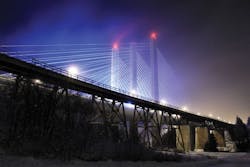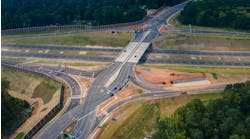One of the most significant elements of the Canadian transportation system is the Trans-Canada Highway, a more than 7,800-km route that touches all 10 of the country’s provinces from coast to coast.
In Ontario, the highway crosses over the Nipigon River—via the Nipigon River Bridge—at one of the southernmost points in the province, just north of Lake Superior. The bridge serves as a critical structure to motorists in the area since the highway serves as the only link across Canada, with no alternative routes to speak of.
The recently completed Nipigon River Bridge replaced a 40-year-old steel plate girder bridge. Work on the bridge began in 2013 as part of a region-wide effort to widen the Trans-Canada Highway to four lanes, in addition to replacing a structure nearing the end of its life. “There was a need to increase the redundancy we have across our network system, which is why a four-lane structure was developed and built here,” Gary Weiss, manager of operations for the Ontario Ministry of Transportation, told Roads & Bridges.
According to Weiss, an additional need the new bridge would address was an improvement to the environmental impact. “The existing bridge had piers in the water,” he said. “There were some old piers there as well that we removed as part of this project, recognizing that the river at this location is one of the premier spawning grounds for the Great Lakes.”
The new structure is a cable-stayed bridge, the first of its kind in Ontario. It was built in two phases, with the center tower shared by the two decks. The reason for this was that the projected south deck was in conflict with the existing bridge. So the project was phased by first building the north deck, switching traffic from the existing bridge to the new north deck, demolishing the existing bridge, and finally building the south deck. “It was one of the first kind of staging of a cable-stayed bridge where we built half at a time, and that was something the design team had to work out in advance,” Weiss said.
One of the challenges the team faced in the design stage for the bridge was working with such a limited project footprint due to the spawning grounds to the north and a railway bridge to the south. The cable-stayed design turned out to be one of the best options in terms of minimizing environmental impact when compared to the alternative girder bridge option. “We did an evaluation on the two different options,” Weiss explained. “The river is a very fast-flowing river, and to try to erect some of these long-spanned girder bridges off barges in this area was just not very practical due to the amount of water that goes through this area.”
For the construction of the bridge, the team adopted a balanced cantilever method of construction, with the piers going up first and then the deck is moved out on each side, simultaneously expanding toward the east and west abutments. Everything above the deck surface was made out of precast concrete, which Weiss explained was for two reasons: for the structure’s durability and to speed up the construction timeline due to the limitations of days with good weather in the region. The bridge deck was all precast concrete on steel girders, which were joined together using an ultra-high performance concrete called Ductal, supplied by Lafarge, which allowed for a small and efficient construction joint to join the precast deck panels together. The execution for the ultra-high performance concrete proved to be challenging for crews due to the way it was mixed with custom-made mixers, and the fluidity of the fresh product required watertight forms to prevent leaks.
As the bridge is the first cable-stayed structure in Ontario, the precast towers serve as a signature aesthetic feature. The Nipigon River Bridge is the only one of its kind in North America with precast towers as high as this, at 50 meters high from deck level and 75 meters high from ground level. The three towers on the bridge are each composed by 24 segments precast with match-cast technique to ensure the verticality during installation, which included post-tensioning bars and strands to ensure temporary and permanent stability. One of the main challenges of the project included the logistics for delivery of the precast elements to such a remote location. The precast towers were cast in Calgary, Alberta—2,135 km away from the site; the steel structure was manufactured in Laval and Quebec City, Quebec—1,700 km away; and the precast slabs for the deck were made in Winnipeg—800 km away.
The team also faced challenging weather conditions, with temperatures ranging from -45°F to -85°F at certain points during the construction process, which would significantly impact the construction schedule. “We had a very cold first winter when construction of the footing was supposed to be done,” Weiss said.
With the help of a contractor with advanced knowledge of newer construction means, methods, and materials, the Ontario Ministry of Transportation was able to open all four lanes of a first-of-its-kind bridge across a critical roadway by the Fall of 2018.



